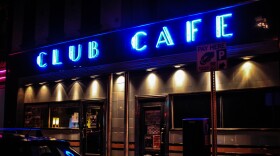Want to own a piece of Pittsburgh history? The former Wabash Bridge piers along the Monongahela River are up for sale for potential buyers with the best offer — and a creative vision.
The pair of masonry structures rise roughly 45 feet above the river on the Downtown side near the Mon Wharf parking lot and over on the South Side near Highmark Stadium. Spiky-looking flag poles poke up into the sky, affixed with rusty steel beams.
“Everybody that’s on the Parkway East has driven by them a thousand times,” said AJ Pantoni, director of industrial services for Hanna Langholz Wilson Ellis, Hanna Commercial Real Estate. He’s in charge of selling the piers. “It’s not typical real estate.”
As an industrial broker, Pantone said he’s sold close to $20 million worth of former industrial-related sites along the Ohio and Monongahela rivers.
“But selling a bridge pier? I don’t know who’s ever done it.”

Origins of the Wabash Bridge and Tunnel
The Wabash Bridge from Station Square to Downtown — and an accompanying roughly 3,300-foot tunnel underneath Mt. Washington — were built between 1902 and 1904 by the Wabash Pittsburgh Terminal Railway. Railroad executive George J. Gould conceived of the idea in an effort to compete with other rail lines at the time. But according to Adam Prince, who writes about Pittsburgh history for his blog gribblenation, the project had bad luck from the start.
“There were landslides, there were fires,” Prince said. “Ten people died because part of the bridge collapsed [during construction.]”
The Wabash Bridge and Tunnel operated for several years until 1908, when the company went bankrupt. It was a hard time to be a small rail company, and the Wabash system was purchased by another rail line. As automobiles became more popular, Prince said Allegheny County officials began to look at opportunities to include the span in its urban highway plans. Some plans would take drivers through the Wabash Tunnel, over the bridge and into Downtown with an interchange near Point State Park; another would create a roundabout near Saw Mill Run Boulevard and the tunnel. None of the plans worked out.
“This was one of the many different variety of proposals in Pittsburgh, especially in that era in the 30s, as the automobile era came about,” Prince said. “Obviously, it fell apart. The city and the county tried a lot of different ways of trying to get funding, and never got the money.”
Freight service over the span ended in the 1940s, when officials said it was finally time for the Wabash Bridge to be demolished. Part of the steel was reused in the construction of the Dravosburg Bridge (also known as the Mansfield Bridge), which spans the Monongahela from McKeesport and Dravosburg.

But the piers remained, as did the tunnel. For a couple decades, not much happened at the tunnel until an innovative transit system idea called Skybus emerged. Sometimes called the people-mover, the futuristic transit system was designed to be autonomous and take riders on a raised concrete track throughout a planned 92-miles in Allegheny County. Part of that route would use the Wabash Tunnel, and Prince said the former Port Authority — now Pittsburgh Regional Transit — started to get the roadway ready.
“For lack of a better word, they had a median on it. So the bus would just glide on it,” Prince said. “They hadn’t put the track down yet, but they had everything set for it.
But Skybus didn’t work out either. PRT used the tunnel to store buses for a while, and then in the ‘90s, it was converted for vehicular traffic. Today it’s used as a reversible HOV lane between Woodruff and West Carson streets.
New owners
Unlike the tunnels, the piers didn’t see a lot of actual change after the bridge was demolished. According to A.J. Pantoni, the piers came up for auction in 1979 and a self-described riverman and business owner named Graydon Crain bought them.
“His take on it was, how else could I own property in the city of Pittsburgh for what I could buy a Cadillac for?” Pantone said. “So he paid $18,000 in 1979.”
For years, barges and tugboats were moored there, and Crain would sometimes allow advertisements. Pantoni says when Crain died in 2020, the piers were part of his family trust. Since putting them up for sale last year, Pantoni’s heard a lot of ideas for their future, including a public art space, a small marina or a place for billboards.
“It's a platform above river level that's right next to a major roadway,” Pantone said. “And it's in how many [photographs] of the City of Pittsburgh?”

Another idea comes from the Southwestern Pennsylvania Climbers Coalition, a group that advocates for development of climbing and bouldering in the region. Director of access and stewardship Mike Varlotta says the organization has had its eye on using one of the piers for climbing for years:
“We could easily put four or five routes on the riverside, four or five routes on the bike path side,” Varlotta said. “It’s probably one of the highest-profile pieces of real estate in the city.”
He said people have been climbing abandoned urban structures for decades, and sees the sale of the piers as an opportunity to showcase the city’s growing outdoor recreation scene. They’re still talking with partners and potential stakeholders about what that could look like, but Varlotta says he could see financial benefits for Pittsburgh.
“If we could do it here in the city, not only would that keep more of the climbers around more often, but it would bring more people in our region here because they’d get to rock climb and visit a super cool city,” he said.
The piers are still for sale, and Pantoni said the real estate company and family would like to see them used for something unique.
“It just really comes down to who has the vision to do something with it.”
The price is negotiable.














